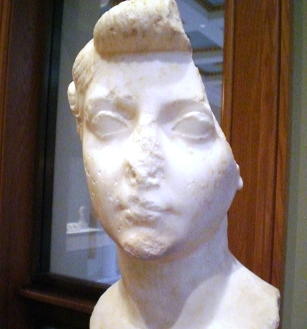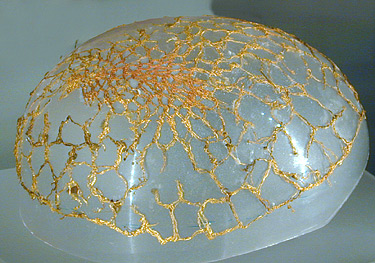|
|
|
|
|

Roman Women and Beauty: Poppaea Sabina.
Poppaea Sabina was the
wife of the Emperor Nero. Marble Bust, 1st c AD. National Museum of Rome, Palazzo Massimo.
Poppaea Sabina was considered a great beauty in her time.
For more on hairstyles:
Glorious Roman Hairstyle Photos
You-Tube:
How to make a Roman
hairstyle: ( Empress Sabina: Ancient Roman
Hairdressing," by professional hairstyle-archeologist Janet Stephens)
|
|
Roman
Women and Beauty
The Beautiful Women in Ancient Rome spent a great deal of time on personal grooming and
beauty preparations.
How did they learn about and decide on beauty standards, fashions, and
treaments? There were several ways they learned and drove fashion and
beauty trends:
* With attendants and escorts, they went shopping or had fine goods
brought to them.
* They attended festivals, sacrifices, games, and entertainment with
other elite women. In December of each year, Romans celebrated the
women-only festival to the Bona Dea (Good Goddess), the goddess of
female fertility.
* They acted as hostesses and dined in each other's houses.
* They
attended women-only social and religious events. |
|
|
|
|
|
|
|
|
As Rome became wealthier and
more open to conspicuous consumption, the whole
gamut of the beauty racket--cosmetics, hair wigs and
styles, jewelry, fine garments-- exploded.
To be a Beautiful Woman in ancient Rome required
exotic techniques as well as time and money.
Livia
Livia, the wife of the first Roman
Emperor, Augustus, was known for her elegance as
well as her modesty. Livia went to a great deal of
effort to look
the part. As a strong-minded Empress, Livia exerted
an enormous influence over the social and political
lives of elite women.
Even when her portrait bust was made at age 60, she
commanded to be shown as a much younger woman.
Here's what it took to "look the part."
Livia employed an enormous staff:
--Hair and make-up artists. Experts today think the more
elaborate Roman hairstyles were held in place with
rope.
For richer
patrons, gold filaments were woven into the hairnet.
The hairstyles lasted for days.
--Dressers (in Latin "ornatices") -- perhaps the fashion stylists of
the day.
--Wool workers
("lanipendi") and sewers ("sarcinatrices"), who made the clothes.
"Keepers
of her wardrobe" cleaned, folded, and mended them.
Since Livia was also a priestess, there had to be a separate specialist
to look after her priestly garments and accessories.
--A specialized shoemaker ("calicator") for her shoes.
--A goldsmith ("aurifes"), a gilder ("inaurator"), and a
pearl setter
("margaritarius") for her jewelry.
--And of course a
masseuse.
The modest look was indeed expensive! |
|

Livia, wife of
Emperor Augustus.
Marble Bust (fragment). 1st c. Getty Villa.

Hairdressing.
Painted fresco panel from Herculaneum, Italy. 1st c
AD, Naples, National Archeological Museum.
Courtesy: Barbara McManus, VROMA.

Hairnet
(remnants).
Palazzo Massimo. Photo
courtesy VRoma.
|
|
|
|
|
|
|
|
|
|
|
Cosmetics and Galen
Galen, the famous Greek physician of the 2nd c AD, wrote also about
cosmetics.
He approved of cosmetics to
prolong beauty.
But he frowned upon other beauty procedures, such as dying your hair or
bleaching your skin.
To him, they were "unnatural."
On the 13th of August each year, Roman women were supposed to wash their
hair.
|
|

Galen,
(idealized
bust).
Courtesy:
Science Photo Library.
|
| |
|
|
| |
|
|
| |
|
|
Women's Clothes in Ancient
Rome
The tunic
The tunic was constructed from
two rectangles of fabric sewn at the sides up to the
underarms. To hold it in place vertically, it was
sewn, pinned, or buttoned over the shoulder.The stola
On top of the tunic went the
stola. A woman put on a stola to indicate she
was married.
The stola was sleeveless with straight, flat straps at the shoulder. Here the two straps were
fastened by pins, brooches, or sewn together.
For a neckline, the stola was a scoop-neck design; peeking out from under it was the tunic
with its higher neckline. Like the tunic, the stola was belted at the high waistline and was full-length.
The palla
When appearing outside the
home, a Roman woman would wear a palla, a drape-y long cloak on top of the stola
and the tunic.
A properly
dressed Roman matron would have the palla covering
the back of her head with one end draping down the
front of her shoulder. The palla then flowed down
her back or encircled her hips, with the other end
of the garment terminating in a gracious fling over
the other, outstretched arm.
The
palla gave her warmth and protection from the
elements. It also ensured propriety. |
|

Venus.
Marble, Roman. Getty Villa.
The first layer is the tunic
with its high neckline. On top of the tunic was
added the stola. The stola is belted at the high waist and drapes to
the floor.
The third layer is the palla. It covers both her shoulders,
with one end flung over the outstretched right arm. |
| |
|
|
|
Updated 09-December-2016. You may contact me, Nancy Padgett, at
NJPadgett@gmail.com |
|
|
|
|